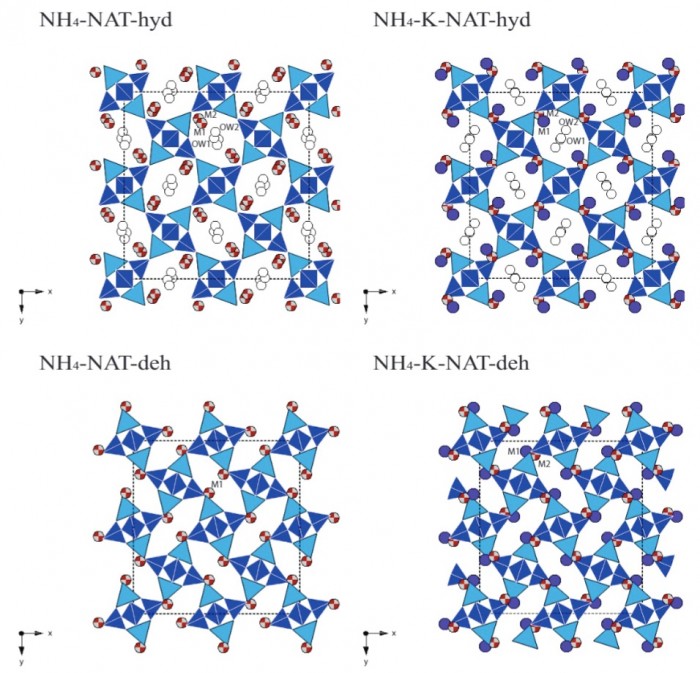“Structural studies of NH4-exchanged natrolites at ambient conditions and high temperature”
- Authors
Y. Lee, D. Seoung, Y.-N. Jang, J. Bai, Y. Lee*
- Journal
American Mineralogist
Vol.96, No.1, pp.1308-1315, 2011.08 - DOI
Abstract
We report here for the first time that fully and partially NH4-exchanged natrolites can be prepared in hydrated states using the solution exchange method with potassium-natrolite. The structural models of the as-prepared hydrated phases and their dehydrated forms at elevated temperature were refined in space group Fdd2 using in situ synchrotron X‐ray powder diffraction data and Rietveld methods. The unit-cell volumes of the hydrated NH4-exchanged natrolites at ambient conditions, (NH4)16(2)Al16Si24O80·14.1(9)H2O and (NH4)5.1(1)K10.9(1)Al16Si24O80·15.7(3)H2O, are found to be larger than that the original sodium-natrolite by ca. 15.6% and 12.8%, respectively. Upon temperature increase, the fully NH4-exchanged natrolite undergoes dehydration at ca. 150 °C with ca. 16.4% contraction in the unit-cell volume. The dehydrated phase of the fully NH4-exchanged natrolite exhibits marginal volume expansion up to 425 °C and then becomes amorphized during temperature decrease and exposure to atmospheric condition. In the case of the partially NH4-exchanged natrolite, the dehydration starts from ca. 175 °C with ~15.1% volume contraction and leads to a partial phase separation to show a phase related to the dehydrated K-natrolite. The degree of the phase separation decreases with temperature increase up to 475 °C, concomitant to the gradual volume contraction occurring in the partially NH4-exchanged natrolite in the dehydrared state. Upon temperature decrease and exposure to atmospheric condition, only the dehydrated K-natrolite is recovered as a crystalline phase from the partially NH4-exchanged natrolite. In the hydrated model of the fully NH4-exchanged natrolite, the ammonium cations and water molecules are statistically distributed along the elliptical channels, similar to the disordered pattern observed in natrolites exchanged with larger alkali metal cations such as the K-, Rb-, and Cs-forms. The dehydrated model of the fully NH4-exchanged natrolite at 400 °C is essentially same as the one reported previously from the sample prepared by direct melt exchange method using sodium-natrolite. Both the hydrated and dehydrated structures of the partially NH4-exchanged natrolite at RT and at 400 °C, respectively, are characterized by having two separate sites for the ammonium and potassium cations. Comparing the structural models of the monovalent cation forms studied so far, we find that the rotation angle of the natrolite chain is inversely proportional to the cation radius both in the hydrated and dehydrated phases. The distribution pattern of the non-framework species along the natrolite channel also seems to be related to the non-framework cation radius and hence to the chain rotation angle.












